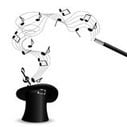The Purpose of Audio Reproduction
Time to crack this back open again, 😄.
Yes, what's the point? There could be a zillion answers, but my answer is to be true to the contents of a recording ... I was going to post this to that unloved thread, now gone to zombie land, but I'll do it here, instead,
Bit of a mess, eh? And, this is the remaster, from 2015!! - I've got it on a double CD from 1998 - a low cost release - sludgy, plus? ... You bet!
What should a system do to, for this? In my book, absolutely nothing more than the best job possible to being accurate to the data - now, what I'm getting at the moment is not elimination of the sludge - but is a realistic pickup of what was heard in that club. The reproduction, currently, is not the best it could be - my active speakers still need to be refined more; which will gain me greater clarity, a better connection to the musicians doing their thing ... this sort of track is very helpful in making it clear where the shortfalls are.











479 Comments
Recommended Comments